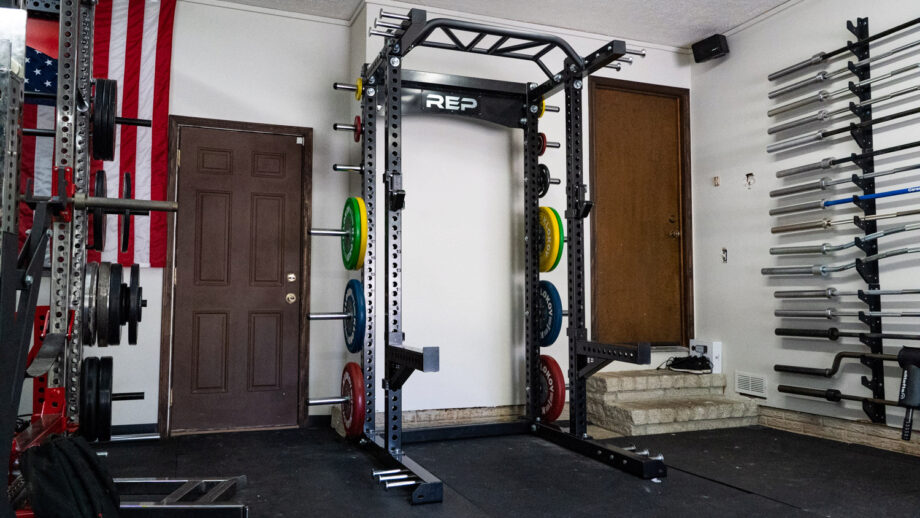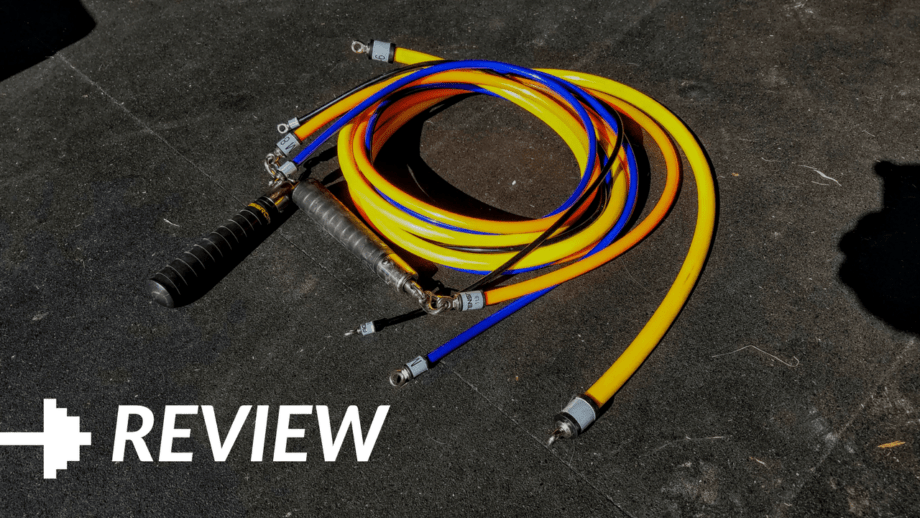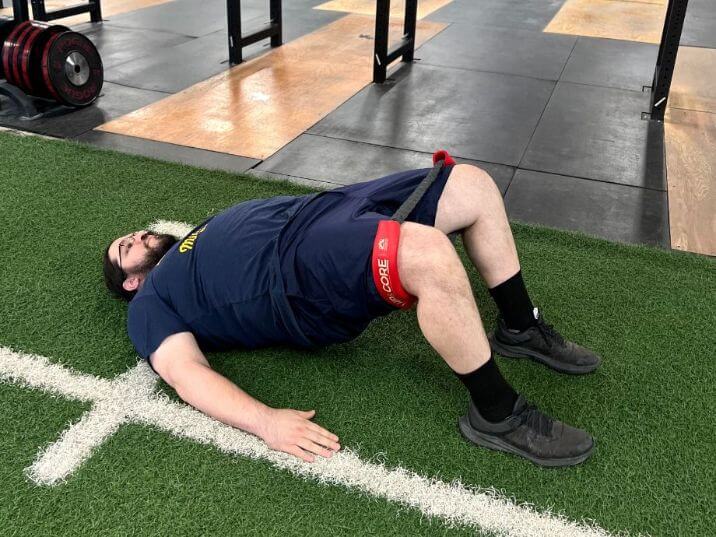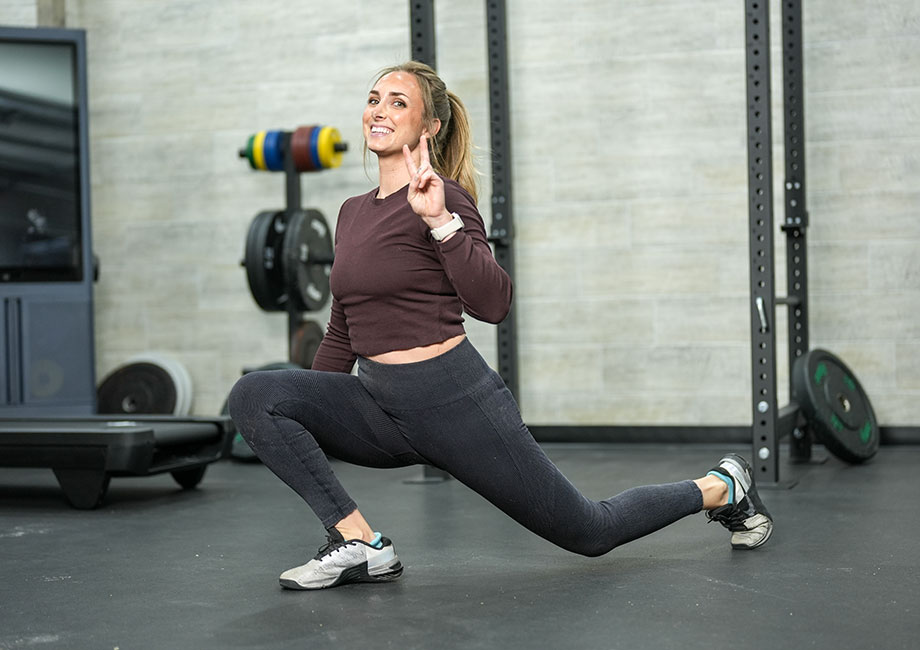Has a deadlift plateau stopped you dead in your tracks?
The deadlift is one of the best, most functional exercises at your disposal in the gym, so it can be very frustrating to feel like you’re hitting the same brick wall over and over again whenever you try pushing past your current deadlift PR.
You’ve tried supplementing with similar exercises. You’ve made sure you’re eating right and getting a good night’s sleep. But it’s all for naught and you’re at your wits’ end. Something’s gotta give.
Well, fitness friend, we’re here to teach you how to rack pull.
Rack pulls are a deadlift variation that uses a partial range of motion, often performed from knee height, that targets and strengthens the same muscles involved in the conventional deadlift. They provide the similar benefits as the deadlift, including increases in strength, size, and power, making them an invaluable tool for improving your deadlift technique, and, in time, pushing through the sticking point that’s been giving you so much trouble.
Does it sound too good to be true? We’re dead serious.
Using the rack pull effectively takes your deadlift from dead in the water to drop dead gorgeous. Today, we’re breaking down rack pulls, including how to rack pull with excellent form and how to avoid the most common mistakes associated with the exercise.
Get ready to knock ‘em dead and get those gains!
How To Rack Pull
- Set the safeties of your squat rack or power rack to knee height or slightly above, depending on your desired range of motion. Load your barbell and set it down on the spotter arms.
- Stand with your feet shoulder-width apart, your shins close to the bar, and your toes pointed forward, as you would with the standard deadlift.
- Bend your knees and hinge at the hips to grip the bar with a mixed or overhand grip.
- Inhale and brace your core as you begin the lift.
- Push through your heels and lift the bar. Keep your back straight, core tight, and shoulders pinned back and down throughout the movement.
- Drive your hips forward as you stand up straight, squeezing your glutes and keeping the bar close to your body.
- Pause at the peak position, then slowly return to the starting position.
- Repeat as needed.
RELATED: How To Deadlift Heavier: Expert Training Tips And Tricks To Help You PR
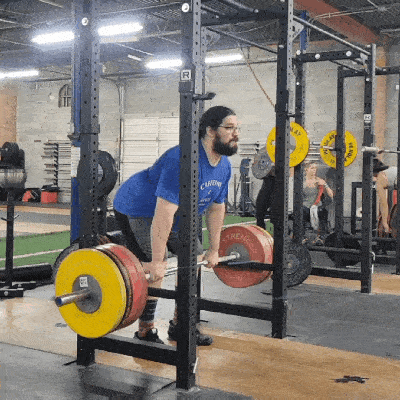
Trainer Tips for Form
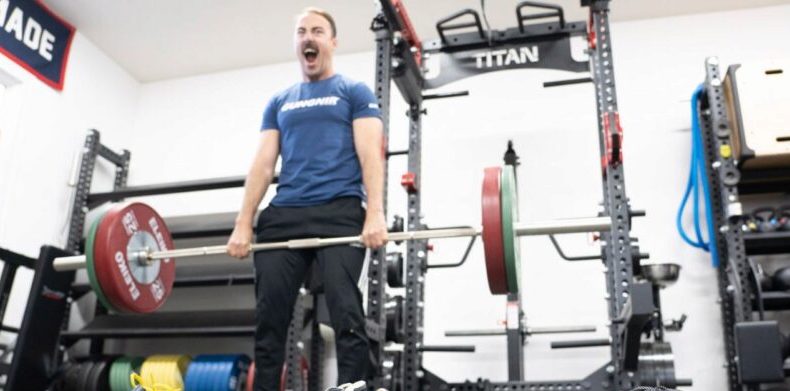
The rack pull seems unassuming since it uses a shorter range of motion, but don’t let it fool you. Rack pulls can still be very challenging, so you should approach the rack pull with the same focus as you would for the regular deadlift and make sure your form is picture perfect.
Here are tips from a personal trainer on how to get the rack pull right.
Keep Your Back Straight
Rounding your back to reach down for the bar is a big no no. Just as you would during your regular deadlift, keeping a flat back and neutral spine is paramount and will reduce your risk of injury. It ensures your back muscles properly support the spine and saves you from injuries like sprains, strains, and disc herniations.
Plus, you are physically able to employ more strength during the lift with this positioning. Maximize the effect of the lift and minimize your risk of injury by making sure that back stays straight from start to finish.
Engage Your Core
Keeping a tight core provides support to the low back region, helping reduce your risk of injury. One way to remind yourself to hold tension in the abdominal muscles is to take that big breath before initiating the lift.
Wearing a weightlifting belt will help remind you of this as well, as you’ll need to push against it to use it properly in the first place and, therefore, will maintain tension in the core.
Keep the Bar Close
Swinging the bar away from the body places undue stress on your lower back, among other muscle groups that are activated during the rack pull.
If you’re initiating the lift at the knee or above, you’re less likely to swing out accidentally than you would if you were avoiding clonking your kneecaps on the way up. Regardless of where you start the lift, keep the bar close to your body and work to maintain a straight bar path.
Drive Through Your Full Foot
You would not be able to lift anywhere near as much weight during the deadlift if you relied solely on your arms. Although you do need some arm and grip strength to maintain control of the bar, the real power comes from pushing through your full foot and engaging your glutes and hamstrings. The real power comes from your legs during the deadlift and, therefore, during the rack pull as well.
Move With Control
We’ll give you a pass if you’ve controlled the ascent of a heavy rack pull and need to let it drop once you’re in the standing position.
Generally speaking, however, you want to move slowly and control the bar at all times. Don’t explode out of the starting position or slouch yourself back to the starting position after the rep. Trying to cycle reps using jerky movements will do little more than increase your risk of injury.
Take it slow and keep it controlled. Maintaining proper form should always be the top priority.
Common Rack Pull Mistakes
Following our above trainer tips is a great way to avoid making mistakes when doing a set of rack pulls. Here are some of the most common mistakes beginners tend to make when they’re not yet familiar with proper rack pull techniques.
Rounding the Back
Rounding the back is a cardinal sin when it comes to deadlifts and rack pulls. It weakens your position, reduces the amount of power you’re able to produce, and, worst of all, increases your risk of injury.
Save yourself from a slew of nasty injuries by checking in with your form on each rep and making sure that your back stays flat and straight at all times. The rising and falling movement comes from hinging at the hips and extending the knees, not slouching.
Overextending at Lockout
Sometimes we get a little overzealous after successfully standing up straight during the rack pull. Feeling like an absolute boss, we overextend the lower back, leaning in an unnatural way, or lock our knees.
Overextension causes unnecessary stress on the muscles of the posterior chain and could contribute to injury. When you hit the peak of the movement, stand up straight naturally and refrain from overcompensating; flat back, tight core, shoulder blades pinned, glutes squeezed, weight in your heels.
Setting the Safeties Too High (or Too Low)
The rack pull uses a shorter range of motion, but you’ll shorten it too much and get minimal activation, if any, if you set your safeties too high. Likewise, setting the safeties too low will make the rack pull too reminiscent of the deadlift and, therefore, detract from its usefulness.
Keeping the rack’s spotter arms close to the knee, approximately 2 or 3 inches above or below, is often sufficient to reap the benefits of the rack pull during your set.
Pulling Too Quickly
It’s common to try squeezing in your strength training between getting out of work and picking up the kids from soccer practice, but rushing through your rack pulls is a bad idea.
Pulling too quickly or trying to rapidly cycle your reps nearly guarantees you lose that ever-essential proper form somewhere during the set, leading to unnecessary stress on your muscles and increasing your risk of injury.
Lift slowly and deliberately, control the bar during the ascent and descent, and reset your positioning between reps to ensure you’re keeping good form at every stage of the rack pull.
Going Too Heavy
It’s easy to underestimate the rack pull because it doesn’t involve the full range of motion you’d use for a standard deadlift. However, the rack pull is a demanding exercise that places a lot of stress on your posterior chain.
Start with fewer weight plates on the bar and really get comfortable with the movement before trying to move onto heavier loads. As you build a strong foundation and become familiar with the exercise, you will be able to perform rack pulls and move heavy loads with less risk of injury.
Rack Pull Variations
Just as there are numerous deadlift variations available, there are many rack pull variations, too.
Block Pull
Are you trying to get in a set of rack pulls but you don’t have a squat rack or power rack? Do you happen to have a set of blocks or a few spare bumper plates handy?
The block pull is a common variation because it is identical to the standard rack pull, swapping out the safeties of a rack for any sturdy objects you have available that could provide the height you need to achieve the correct starting position.
Isometric Rack Pull
The isometric rack pull is a nifty trick that takes the movement of the rack pull and changes the stimulus immensely. Instead of loading weight plates onto your barbell and lifting the bar to the lockout position, you set an additional set of pegs into your rack and lift an empty barbell into it with all your strength.
Holding tension during an isometric rack pull changes the stimulus to your muscles significantly and helps build strength to overcome that pesky sticking point.
Banded Rack Pull
Many fitness enthusiasts are already aware of the benefits of resistance bands, and the seemingly endless versatility you can get from a portable, inexpensive piece of gym equipment.
To perform banded rack pulls, simply wrap a resistance band underneath the rack and safely secure it at each end of the barbell. You will need two identical resistance bands to achieve the right effect.
Adding a resistance band to your rack pull alters the stimulus as well, adding in dynamic tension that makes the lift more difficult the closer you get to the lockout position. By practicing rack pulls with a resistance band around the barbell, you’ll feel a world of difference once the bands are removed, and you’ll break through that plateau in no time!
RELATED: How Effective Are Resistance Bands? We Have The Truth
Useful Rack Pull Equipment Accessories
So, you’re a rack pull aficionado now, and you’re looking to next level your next workout.
No problem. We’ve got some great recommendations for gear that will help you kick things up a notch during your next sesh. Bam!
Weightlifting Belt
A clinical trial published in the journal Medicine & Science in Sports & Exercise1 determined that “the use of a lifting belt increases [intra-abdominal pressure], which may reduce disc compressive force and improve lifting safety” during compound barbell lifts like the deadlift and, you guessed it, the rack pull.
Lifting belts decrease your risk of injury and often allow you to lift heavier weights due to the improved support. As you progress along your fitness journey, it’s worth trying out a weightlifting belt and seeing if it’s a good fit for you and your fitness goals.
RELATED: Best Weightlifting Belts For Powerlifting, Olympic Lifting, CrossFit, And More (2024)
Lifting Straps
As you become more fatigued and your grip approaches failure, lifting straps are there to bail you out by wrapping around the bar and maintaining a secure connection if your grip slips.
You by no means want to rely on lifting straps and totally neglect building grip strength and pulling strength, but they’re useful during those final sets when the loads are approaching their heaviest and your grip is wearing thin.
Deadlift Shoes
If you’re already accustomed to wearing deadlift shoes for the traditional deadlift, you’ll probably also want to use them for rack pulls too since the movement is so similar, albeit with a shorter range of motion.
The deadlift shoe has trademark flat, hardened sole that gives you more contact with the ground, improving your balance during the lift and decreasing the perceived amount of effort on the lift.
Of course, there’s no law against performing deadlifts or rack pulls in regular sneakers, but deadlift shoes do provide an edge over their garden variety counterparts.
FAQs: How to Rack Pull
What is the point of rack pulls?
The deadlift is commonly considered one of the be-all-end-all best back exercises to include in your workout arsenal. Rack pulls are an extension of that, often incorporated as a tool for improving your deadlift technique, building strength, and encouraging hypertrophy. Regularly performing rack pulls should enable you to move progressively heavy loads during the conventional deadlift.
Rack pulls help you accomplish not only because it’s a shorter trip from the starting position to full lockout; it’s also because the rack pull highlights a specific portion of the lift and allows you to give all your strength for this one specific section.
That means if you have a sticking point during the regular deadlift, you can effectively set the safeties of your squat rack and start your rack pull close to this point. When you go in to engage, you’ll have more strength to move through the sticking point to help develop the involved muscle groups and eventually pass this point on your regular deadlift.
When incorporated properly, rack pulls are invaluable for building a better deadlift and improving your technique. For more insight on how to add rack pulls into your workout routine, consult a certified personal trainer.
Are rack pulls harder than deadlifts?
Rack pulls can be challenging, but they are generally considered easier than deadlifts due to the shorter range of motion.
Are rack pulls worth doing?
Whether or not rack pulls fit into your regimen will depend on your fitness level and personal fitness goals. Casual gym goers, all-purpose athletes, and novice lifters may be satisfied with their current deadlifting abilities and, therefore, may not see a need to spend time on rack pulls.
On the other hand, rack pulls are very valuable for those who want to really push their deadlift boundaries, including competition weightlifters, powerlifters, bodybuilding contestants, and other strength athletes.
Are rack pulls just as good as deadlifts?
The rack pull is a great exercise, but it loses just about every category in a side-by-side comparison with the good old-fashioned deadlift. Because of the reduced range of motion required to perform rack pulls, it just can’t measure up.
Deadlifts involve a greater range of motion, which in turn requires greater lower body strength, more core involvement, and superior mobility and flexibility. Rack pulls are a valuable tool for improving your deadlift, but its uses are more specialized compared to the highly functional regular deadlift.
Do rack pulls build mass?
It’s well-known that deadlifts help build muscle, especially in the posterior chain, but do rack pulls provide the same activation? Can we achieve hypertrophy performing rack pulls? You bet!
Because rack pulls are essentially a partial deadlift, you will still receive good activation in the same muscle groups you use during the standard deadlift, thus encouraging hypertrophy. To maximize your muscle growth potential, be sure you’re lifting heavy weights and working a rep scheme that’s conducive to your goals.
RELATED: How Many Reps To Build Muscle: Advice From A Certified Personal Trainer
References
1. Harman EA, Rosenstein RM, Frykman PN, Nigro GA. Effects of a belt on intra-abdominal pressure during weight lifting. Med Sci Sports Exerc. 1989;21(2):186-190.


